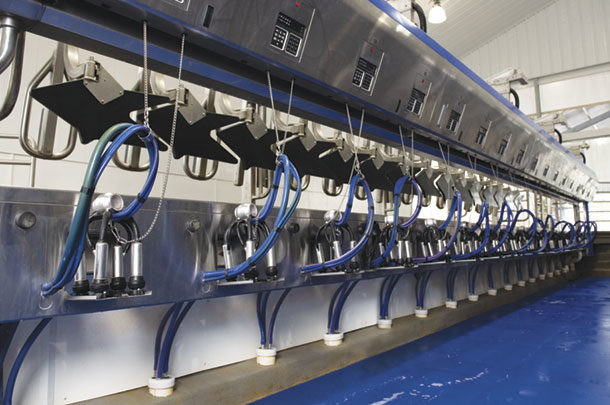The planning, building and startup of a new (or retrofit, rebuild or extension) milking parlor is a uniquely exciting, challenging and stressful event. Financial deadlines are real. Construction fatigue is real.
As the startup date looms closer, the higher the anxiety and the harder the push to “get it done.” Many times, this is when your focus must shift from construction decisions to slowing down and planning for the actual startup date. This transition from a fast, hard-working pace to a slower, more thoughtful action can be extremely difficult, but it is necessary to ensure a smooth transition. Bad startups can lead to safety hazards and months of misery for cows, employees and yourself. Taking the time to create a startup plan for your new parlor and executing that plan (or delegating this task) will pay dividends in the short and long term.
It can milk, but should it?
The moment the vacuum pump is firing and tuned, excitement builds because this new investment can milk cows. However, simply because the vacuum system is operational does not mean it should milk cows. Every parlor installation should follow the National Mastitis Council’s Procedures for Evaluating Vacuum Levels and Air Flow. This test is two-part. First, the dry test (not milking) evaluates the function of components of your vacuum and pulsation system with the goal of ensuring the system is operating within the manufacturer’s recommendations.
Doing this test prior to startup is recommended because of the amount of time it takes to complete. Once milking, the dynamic or wet test is performed while under milking load to ensure the adequacy, stability and regulation of the vacuum system while being used under intended conditions. These tests may be necessary for manufacturer warranty coverage. Additionally, having your system completely evaluated before and during early operation is your assurance it is installed and functioning properly.
It can milk, but can it wash?
Preparing to clean your new milking system should have the same level of priority as preparing for milking. Construction delays hinder progress in many ways. Delays on water availability can have massive impacts on the ability to clean a new system. Setting up a cleaning system for a parlor is a mix of science and art. New wells may present unexpected challenges for sediment, volume, water pressure and water quality. It is imperative that new waterlines be flushed clear of all sediment, and some will need filtration systems installed. The mineral content of your water determines chemical compatibility of your wash program.
The bacterial profile and load of your water can severely influence your milk quality. Water cultures have a four- to seven-day turnaround and may reveal the need of a treatment system. Ensuring water is available in the facility four weeks in advance will allow you to adjust to changing needs.
It can milk, it can wash, but is it safe?
When considering whether or not it’s time to start milking in a parlor, be sure to critically evaluate the environment you are introducing to your cows and people for the first time. Cows and people will be stressed simply because of the change in the environment. Steps must be taken to ensure their safety. Make sure all moving components are operational and have been safety tested. Ensure the footing under cows will allow for the best traction possible. Walk the cow path and critically evaluate for safety hazards, specifically scanning for construction debris, sharp edges, pinch points and traps.
Create a down-cow protocol for your new parlor before it starts. Consider the size of the cow groups your staff can easily and safely control. Train everyone who will be working in and around the new parlor in the safe operation of all the equipment. Displaying easy-to-understand guides explaining the functions of these new buttons will provide another layer of safety and reassurance to employees.
It can milk, wash and is safe, but is it finished?
Hard deadlines may dictate the start of milking before construction is complete or, for retrofits, you may be building in place while milking. Construction noise and activities during milking create a stressful experience for cows. Visible, audible and odor changes from milking to milking will negatively influence behavior and milk let-down. This will not only affect yield during that milking session, but may have longer negative effects on cow behavior. Cows thrive on consistency. If they are met with daily changes, then expect the “startup experience” to be repeated until they are presented with a consistent and calm milking environment. Ask yourself: Can delaying the startup day to allow time for finalizing the build process prevent weeks to months of issues with cow flow, milking and people performance?
It’s go-time! Are you sure?
Months in advance, outline expectations for a go/no-go scenario. Is what you need and want in place, completed and operational before milking? Once you make the list, stick to the list. Do not compromise on what you determined was important when you are in the heat of startup excitement and stress. Have all of the necessary products on-hand and accessible, including items such as teat dips, cleaners, milking gloves, aprons, enough towels for a complete milking shift and an operational washing machine and dryer. Startup events can be rough on equipment. Be sure to stock extra milk hose, pulsation tubing, short milk tubes, liners, shells, claws and all of the clips, chains, retract ropes, etc. For many startups, especially rotaries, I recommend having a fully loaded milking claw and cut-to-length hoses ready to switch out if something is damaged while milking. These may seem like small or trivial things, but they are all components necessary for good milking.
Do you have enough people to safely and calmly load cows in the parlor and milk them? The first experience will dictate how quickly cows and people settle into the new environment. Startup milking sessions last much longer than a regular milking session because cows and people are learning. Providing a cow-friendly experience the first and every milking will speed up the cow transition. Making considerations for shift length and providing plenty of breaks, complete with a place to rest, refreshments or meals will keep your employees rested, focused, fueled and valued. The desire to be on-site for every moment is understandable, but stagger management so everyone, including you, gets enough rest and sleep.
Focusing on the design, the construction and the end result of a new parlor comes naturally to most of us. Focusing attention and planning out the process that will lead to the realization of your ideal is challenging in an unfamiliar way. The transition is part of the foundation of your facility. Investing energy into this process is as crucial of an investment in your dairy’s future as the new parlor itself.







